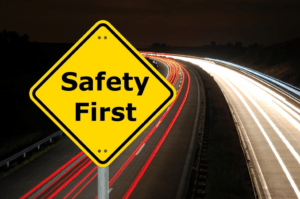We all know that smartphones distract drivers. In fact, they’re one of the most common sources of distraction. And though it’s good that public safety campaigns raise awareness of the risks they cause, it’s important to understand they’re not the only cause of distraction.
If we want to be sure that our roads are as safe as possible, we need to remember about all the other ways drivers lose their focus.
There are countless ways drivers can be visually, mentally, and physically distracted behind the wheel, and all of them put other motorists at risk. Let’s break down the most common forms of distraction outside of cell phone use.
5 of the Most Common Distractions (That Aren’t Smartphones)
Extensive research has been conducted on the ways certain activities distract drivers. The findings illustrate just how vulnerable we are to a lack of focus. The most common distractions include:
Talking to passengers: Engaging with passengers is the leading cause of distraction-related crashes. It’s especially problematic among teens, who are less experienced than older drivers and more likely to make mistakes when distracted.
Looking outside the vehicle: Looking at events, people, or objects outside the vehicle is also called rubbernecking, and it can take a driver’s eyes off the road for several seconds—long enough to double their chances of crashing.
Eating or drinking behind the wheel: Eating food or drinking beverages is far from harmless behavior. It can more than triple a driver’s risk of being involved in a crash.
Reaching for items inside the vehicle: In studies of observed distracting behavior, reaching for items in other seats represents about 3% of all distracting activities. It has the potential to take a driver’s eyes, hands, and mind off the task of driving.
Using the car stereo: The car stereo or infotainment system can be a source of many distractions. When drivers scan for radio stations or change the volume, they can be distracted. When they blast excessively loud music, they can be distracted AND unable to hear important warning signs of impending danger, such as sirens or horns.
This is just the beginning of a long list of distracting behaviors that drivers routinely engage in. Smoking, wearing headphones, driving with unrestrained pets, and even using hands-free devices can distract drivers and lead to serious accidents and injuries.
5 Tips to Avoid Distraction Behind the Wheel
Now that we’ve talked about five dangers, let’s talk about five possible solutions, so you can be sure you’re staying as safe as possible on the road.
- Always store temptations (smartphones, food, etc.) in a secure, out-of-reach location.
- Plan your route and program your destination in your GPS before you depart.
- Make sure pets and children are secured in seats and appropriate restraints before you depart.
- If you need a drink or a snack, always pull over to a safe location to eat or drink.
- Finish dressing and grooming before you hit the road—no shaving or applying makeup behind the wheel!
Though you can control what you do behind the wheel, you’re unfortunately at the mercy of the actions of other drivers, too. If you’re injured in a crash caused by a distracted or negligent driver, know that you have legal options for getting compensation.
Injured by a Reckless Driver? We Can Help
If you or a loved one has been hurt in a crash through no fault of your own, contact the Boston car accident attorneys at Jason Stone Injury Lawyers today to schedule a consultation – There’s No Obligation, Just Information ®.
Not Trusting What You’re Being Told?
Better Phone Stone
800-577-5188
 START MY NO OBLIGATION CONSULTATION
START MY NO OBLIGATION CONSULTATION











